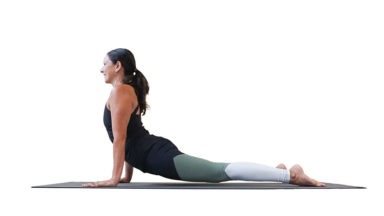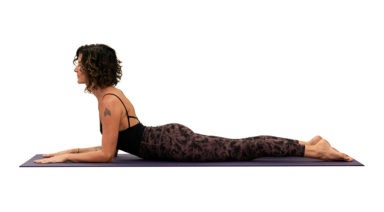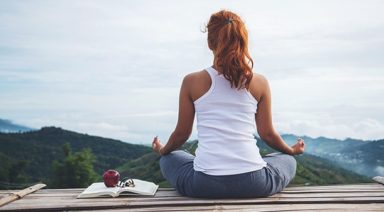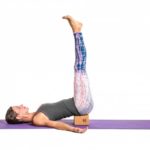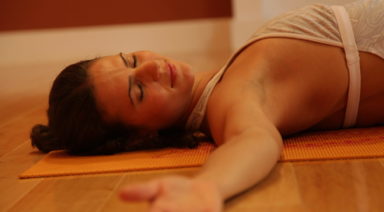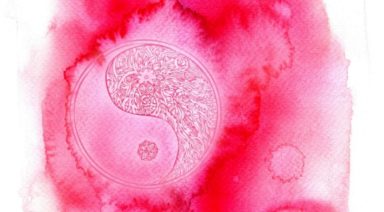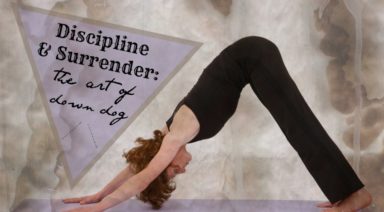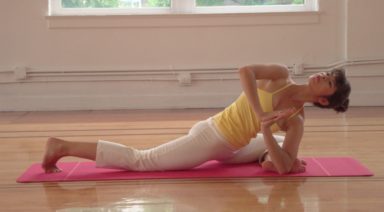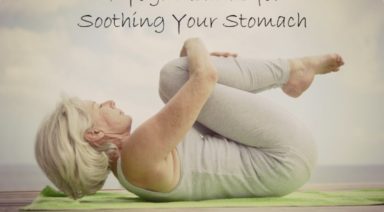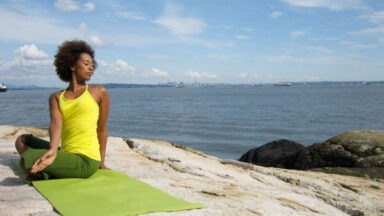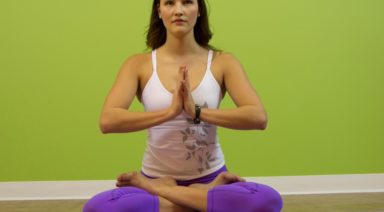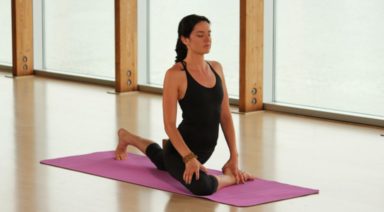Hand to Toe | Yoga Pose

ADJUSTMENTS | BENEFITS | CONTRAINDICATIONS | MANTRA | MUDRA | PREP POSES | SANSKRIT | STEPS | TIPS
Utthita hasta padangusthasana (oo-TEET-uh-HAWS-tuh POD-ung-goos-THAWS-un-nuh), also known as extended hand or hand-to-toe pose, is a challenging and invigorating posture that stretches and strengthens while calming the mind and improving focus. During each exercise, make sure to maintain a focus on your breathing as it hones your attention, focusing your mind on the constant change as you breathe in and out.

ADJUSTMENTS/MODIFICATIONS:
- This pose can be done in stages. Until you are able to do the full expression of the pose, stop at step 2 or 3 and take a few breaths.
- For help with balance, try this pose with your free hand against a wall.
- For tight hamstrings, keep the knee on your extended leg bent, or wrap a strap around your foot and take hold of the strap.
CONTRAINDICATIONS AND CAUTIONS:
Although this is a mild, stimulating posture, you should check with a doctor before performing the pose if you have any of the following conditions:
- Ankle injuries
- Lower back injuries
- Tight hamstrings
TIPS:
This pose stretches the hamstrings and hips. While this can help with relief from discomfort and prevent sprains, exercise caution. Go slowly, and don’t push your body beyond its limits.
STEP-BY-STEP:
- Start in mountain pose with your hands on your hips. Draw your left knee in toward your belly and interlace your fingertips in front of your shin. Engage the bandhas and square the pelvis. Pause here for a breath, enjoying the stretch.
- Reach your left hand on the inside of your left knee, and take hold of your big toe with your first and second fingers. Pause here, finding balance, then extend your foot forward. Straighten your knee fully if you can.
- Keeping your leg straight, extend your foot toward the left. Keep your right hand on your right hip, or extend your hand out toward the right. Keep the shoulders level and relaxed away from the ears.
- For the full expression of the pose, send your gaze over your right shoulder, keeping your chin parallel to the ground.

PREPARATORY POSES:
- Supta Padangusthasana
- Supta Virasana
- Uttanasana
FOLLOW-UP POSES:
- Uttanasana
- Adho Mukha Svanasana
- Bhujangasana
SANSKRIT:
- Utthita: extended
- Hasta: hand
- Pada: foot
- Angustha: big toe
- Asana: pose
PHILOSOPHY & ORIGIN:
Om, or Aum, has deep roots in Hinduism. The sound, produced by chanting or humming, has historically been revered as a sacred sound in the Hindu tradition and is revered as the most sacred of all mantras. The syllables (a-u-m) that compose this mantra represent the various trifectas that are central to its meaning:
- 3 Worlds – earth, atmosphere, heaven
- 3 Major Hindu Gods – Brahma, Vishnu, Shiva
- 3 Sacred Vedic Scriptures – Rg, Yajur, Sama (Source)
This mantra is composed of the entire essence of our universe and is reinforced by the Indian belief that Om is the sacred sound that is the root of everything, created first by God from which all else is derived.
PHYSICAL BENEFITS:
- Stretches hamstrings and hips
- Stretches adductors
- Strengthens back and arm muscles
ENERGETIC BENEFITS:
- Improves sense of balance
- Calms the mind and improves focus
MANTRA:
Om Mantra
This most widely known and used mantra is among the oldest and most widely practiced aspects of the yoga technique. This mantra acknowledges the constant vibrations we are a part of and connected to with the verbal Om. Chanting at different pitches, beginning with low intonations at three to five repetitions and slowly progressing through higher tones, can allow you to focus on the different aspects of our existence, focusing on everything from the physical body to the spiritual dimension.
MUDRA: ANJALI MUDRA
This mudra is also known as the “prayer mudra.”
How to: Bring both hands together by pressing the palms together firmly and evenly with the fingers and the thumb pointing upward.
Benefits:
- Helps reduce weight off the body
- Helps the digestive organs and relieves indigestion
- Holistically boosts metabolism
- Gives revitalized energy and strength to the nervous system
- Sharpens the center within the thyroid gland
- Relieves anxiety (Source)
Legal Disclaimer Before participating in any exercise program or using any fitness products or services that may be described and/or made accessible in or through the Gaia Website and/or the Services, you should consult with a physician or other healthcare provider. Read more about Gaia’s Terms Of Use.
Urdhva Mukha Svanasana: Upward Facing Dog Pose
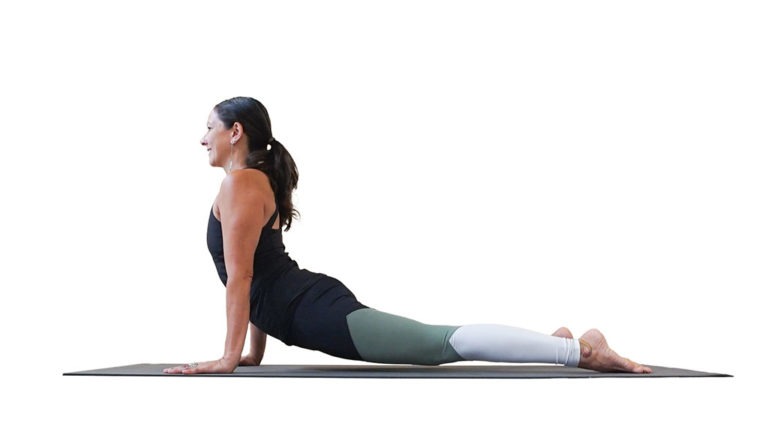
ADJUSTMENTS | BENEFITS | SEQUENCING | SANSKRIT | STEPS
Urdhva mukha svanasana (OORD-vah MOO-kah shvon-AHS-anna) is a challenging backbend commonly seen as part of the transition series in vinyasa yoga.
Philosophy + Origin
The Mahabharata tells a story about a loyal dog who accompanies Yudhishthira, one of the five Pandava brothers, to the gates of heaven. Lord Indra greets the pair at the gates, but tells Yudhishthira that the dog is not allowed into heaven. Upon hearing this, the brother argues for the sake of the dog, telling Lord Indra of its devotion and loyalty. Yudhishthira says that because the dog has been so loyal to him, he will return that loyalty. At this moment, the dog is revealed to be Dharma, and Yudhisthira and his loyal companion are welcomed joyously into heaven. When practicing upward facing dog, remind yourself of the loyalty and dedication you have to your practice and showing up each day in your life. Persistence is always rewarded.









